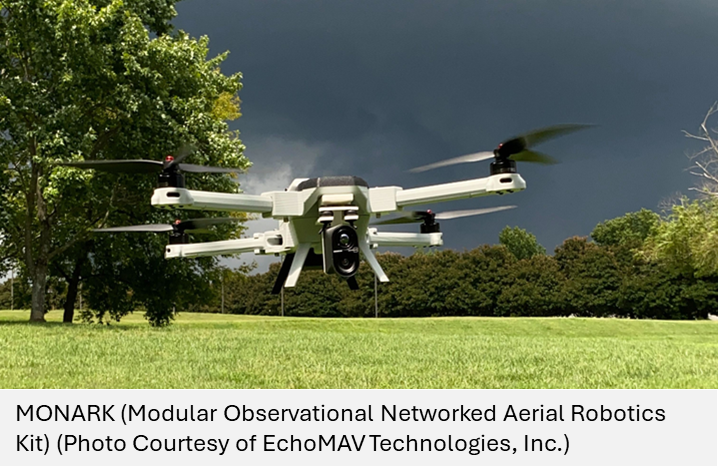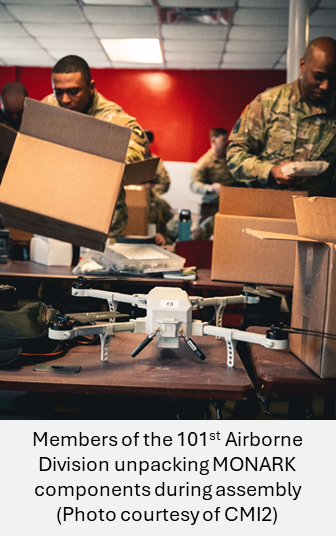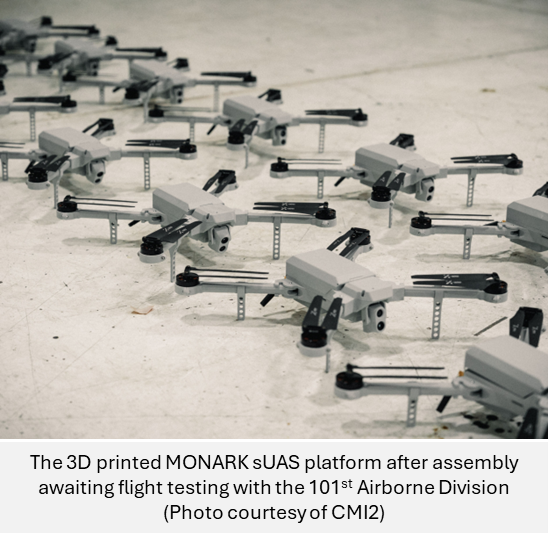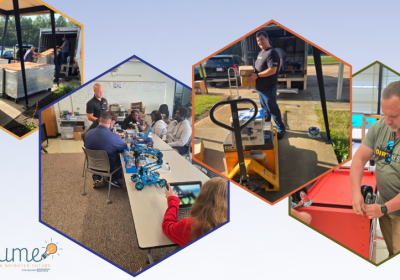May 1, 2025
In today’s fast-paced world of emerging threats and rapid technological change, the future of battlefield success increasingly depends on one powerful force: the ingenuity of the Soldiers themselves. Soldier-driven tactical innovation, ideas sourced directly from those on the front lines, is revolutionizing how the U.S. military adapts, fights, and wins.
Instead of relying solely on top-down modernization, initiatives like the Catalyst-Pathfinder program, managed by DEVCOM ARL and supported by CMI2, and innovation hubs like the EagleWerx Applied Tactical Innovation Center show that empowering Soldiers leads to faster, more cost-effective breakthroughs.
Driving these efforts are key leaders like Robert Leach, a former 5th Special Forces Group Master Sergeant, and current CMI2 Pathfinder Warfighter Innovation Chief engaging Soldiers at Fort Campbell, KY. With over two decades of operational experience, Leach plays a crucial role in connecting Soldiers’ ideas with the resources and expertise needed to transform concepts into operational capabilities, accelerating innovation across the force.
In the following blog, he discusses the tangible ways Soldier-driven innovation is changing the nature of military modernization, specifically why amplifying the voice of the warfighter isn’t just smart; it’s essential for winning tomorrow’s battles.
Soldier-Driven Tactical Innovation:
Empowering the Warfighter and Shaping Modern Warfare
by: Robert Leach, CMI2 Innovation Chief
Introduction
In an era of rapid technological advancement and evolving global threats, the ability of military forces to adapt swiftly and effectively is paramount. Soldier-driven tactical innovation—where ideas and solutions are sourced directly from the warfighters on the ground—has emerged as a critical mechanism for maintaining a strategic edge. Unlike top-down approaches that often prioritize long-term, large-scale modernization, Soldier-driven innovation focuses on immediate, practical solutions to real-world challenges faced in the field. This approach emphasizes enhancing operational effectiveness, fostering adaptability, and bridging the gap between military needs and technological development.
The Importance of Soldier-Driven Tactical Innovation
Soldier-driven tactical innovation is rooted in the unique perspective of those closest to the fight. Soldiers possess intimate knowledge of the operational environment, equipment limitations, and tactical demands—insights that higher echelons or distant research institutions may overlook. This ground-up approach empowers warfighters to identify problems and propose solutions tailored to their immediate needs., In doing so, it fosters a culture of adaptability, encouraging creativity and problem-solving at all ranks.
The strategic imperative of this approach is evident in modern warfare, where adversaries leverage low-cost, rapidly deployable technologies—such as commercial drones—to challenge conventional military advantages. Soldier-driven innovation counters this by enabling rapid prototyping and deployment of countermeasures, often at a fraction of the cost and time required by established systems. Moreover, it enhances morale and ownership among troops, as they see their ideas directly impacting mission success. This democratization of innovation ensures that the military remains agile, responsive, and capable of addressing asymmetrical threats in real-time.
Case Study: 5th SFG(A) and Partner Force Operational Needs
The 5th Special Forces Group’s (5th SFG(A)) Innovation Detachment showcased Soldier-driven tactical innovation by addressing the limitations of existing drone systems—cost-prohibitive, inflexible, and unrepairable in the field. Needing a capable platform to use with Partner Nation forces that could be configured for various mission sets, 5th SFG(A)’s Innovation Detachment partnered with the Civil-Military Innovation Institute (CMI2) and U.S. Combat Capabilities Development Command (DEVCOM)’s Catalyst-Pathfinder program, who sought out a key innovator in unmanned systems to assist in facilitating the prototype.
EchoMAV emerged as a linchpin in this effort, bringing specialized expertise to address the Soldiers’ identified pain points. Rather than adapting existing platforms, EchoMAV crafted a unique sUAS from the ground up, leveraging additive manufacturing to prioritize agility and mission-specific functionality. Labeled the MONARK (Modular Observational Networked Aerial Robotics Kit), this system includes impressive features, like a 40-minute flight time and compatibility with the Android Team Awareness Kit (ATAK), a vital tool for real-time battlefield awareness.

Tailored to handle short-range reconnaissance for conventional and Special Operations units, the MONARK provides a lightweight, affordable option for short range reconnaissance that boosts tactical adaptability, allowing units to conduct various missions more efficiently. While 3D printing is not the most efficient manufacturing option for the body of a drone, the ability of Soldiers to fix their drones in theater at minimal cost makes this decision superior to alternatives. The modular design also allows for National Defense Authorization Act (NDAA) compliance and American-made parts, while simultaneously offering an alternative, non-NDAA-compliant cheaper alternative based on the unit’s needs.
A key facet of the Catalyst-Pathfinder program is scalability. Tactical innovation, by its definition, is the solving of problems directly related to warfighters, and although each unit faces different missions around the world, many share commonalities in purpose. The MONARK initiative began as a U.S. Special Operations Forces (USSOF) need for a versatile, rapidly deployable sUAS to enhance USSOF and Partner Nation Forces operations overseas. The idea began to proliferate across the force through the Catalyst-Pathfinder’s work with conventional and USSOF elements. Now, units like the 101st Airborne Division have embraced the concept, acquiring MONARK to fulfill their short-range reconnaissance requirements. The modular drones are now being integrated into exercises such as Operation Lethal Eagle, a 21-day Division field training exercise, and mark a critical step forward in revolutionizing battlefield reconnaissance. This partnership and collaboration not only accelerate the development and fielding of cutting-edge technology but also strengthens the interoperability between conventional and USSOF units, setting a precedent for future collaborative efforts.
The project’s rapid timeline—spanning just six months from concept to production—underscores the power of Soldier-driven innovation when paired with the right partners. 5th SFG(A) provided operational insights, CMI2 facilitated collaboration, and DEVCOM Catalyst-Pathfinder program supplied the framework for the Soldier-academic-industry partnership.
The Role of Supporting Institutions
The success of such initiatives relies heavily on collaborative ecosystems that connect Soldiers with technical expertise and resources. CMI2 and DEVCOM’s Catalyst-Pathfinder program played pivotal roles in this process.
CMI2, a nonprofit organization based in Morgantown, WV, facilitates direct collaboration between service members, academia, and industry by bridging the gap between Soldier-identified problems and actionable solutions by providing infrastructure and contractor support. In the case of the 3D-manufactured drones, CMI2’s involvement through its partnership with EagleWerx and the 5th SFG(A)’s Innovation Detachment as part of the Catalyst-Pathfinder ecosystem, ensured that Soldiers’ ideas were paired with advanced manufacturing capabilities and external expertise, accelerating development timelines.

The Catalyst-Pathfinder program, a congressional initiative managed by DEVCOM’s Army Research Laboratory, connects Soldiers with academic institutions and industry partners to co-develop technologies. Launched in FY21, the program has empowered units, like the 101st, to work with universities and small industries, producing innovations like the Soldier Assistive Bionic Exosuit for Resupply (SABER) and the Advanced Dynamic Spectrum Reconnaissance Sensor Network (ADSR – SN). For the 3D-printed drones, Catalyst-Pathfinder provides a framework for Soldier-researcher teams to refine designs, leveraging cutting-edge research to meet operational needs. This structured yet flexible approach ensures that Soldier-driven ideas are conceptualized, scaled, and fielded effectively.
DEVCOM ARL is the scientific backbone of these efforts. ARL’s expertise in materials science, additive manufacturing, and unmanned systems supports the technical feasibility of programs like Catalyst-Pathfinder. By operationalizing science, ARL enables tactical units to transition prototypes into deployable assets, ensuring they meet rigorous military standards. ARL’s role in Catalyst-Pathfinder amplifies its impact, creating a partnership that transforms Soldier ingenuity into tangible battlefield advantages.
Eaglewerx, one of the Catalyst-Pathfinder program’s innovation labs, is located at Fort Campbell, Kentucky, and serves all units on post, including both the 5th SFG(A) and the 101st Airborne Division. This lab is home to full-time CMI2 staff, including project managers and innovation engineers to support tactical innovation and modernization efforts for Soldiers. In addition, there is a team of Army officers and non-commissioned officers who work at Eaglewerx full-time to both source and manage Soldier’s innovative ideas from curation to completion. This central hub for innovation is pivotal in the innovative process, providing expertise, equipment, and resources for Soldier’s to prototype their ideas. On top of more than 60 ongoing projects, Eaglewerx coordinated the procurement and Soldier-assembly of 100 NDAA-compliant MONARK drones in just four months.
EchoMAV Technologies Inc. is a U.S.-based company specializing in advanced UAS and is known for its innovative avionics and edge computing solutions and its MK1 group II aircraft. Designed for simplicity and durability, the MK1 leverages a unique hybrid power plant and caters to defense, security, and large-area mapping and surveillance needs. EchoMAV has demonstrated a commitment to cutting-edge, American-made UAS technology. Their ability to rapidly shift focus solely from the MK1 to a 3D-printed sUAS showcases the company’s flexibility and their desires to support the warfighter.
Broader Implications and Future Directions
The 5th SFG(A) 3D-printed drone initiative illustrates the transformative potential of Soldier-driven tactical innovation. It demonstrates how empowering warfighters to design and refine their tools can yield agile, cost-effective solutions that enhance lethality and adaptability. The involvement and collaboration of Soldiers, industry and researchers underscores the importance of institutional support in scaling these efforts, ensuring that grassroots ideas reach operational maturity.

Looking forward, this model could reshape military modernization. As threats evolve—exemplified by the proliferation of cheap drones in current conflicts —the ability to innovate at the tactical level will be a decisive factor. Expanding innovation hubs like EagleWerx and 5th SFG(A)’s Innovation Detachment and increased investment in programs like Catalyst-Pathfinder could institutionalize this approach across the Army. However, challenges remain, including balancing rapid prototyping with safety and testing standards, all the while seeking to integrate these innovations into broader doctrinal frameworks. Addressing these will require continued collaboration between Soldiers, researchers, and policymakers.
Conclusion
Soldier-driven tactical innovation is not merely a supplement to traditional military research and development but a strategic necessity. By harnessing the insights of those on the front lines, as seen with EchoMAV’s 3D-printed drones, the military can respond swiftly to emerging challenges. The Catalyst-Pathfinder program provides the critical support needed to turn Soldier ideas into reality, fostering a culture of innovation that keeps pace with modern warfare. This powerful example exemplifies how empowering warfighters can drive meaningful change, ensuring the U.S. Army remains poised for success in a world of disruption.
About the Author
Robert Leach currently works for the Civil-Military Innovation Institute as an innovation chief on DEVCOM’s Catalyst-Pathfinder program. He served twenty-one years in the United States Army, retiring as a master sergeant from 5th Special Forces Group in 2023, with three combat deployments and seven additional operational deployments throughout the Middle East.
The views and opinions expressed in this document are solely those of the author and do not necessarily reflect the official position or policy of the Civil-Military Innovation Institute, the Combat Capability Development Command Army Research Laboratory, the Department of Defense or the U.S. Government.
Related Articles
Robert Leach previously published The Four Pillars of Tactical Innovation: A Path for Impactful Disruption in February 2024 through the Modern War Institute at West Point. The article was subsequently selected for inclusion in the Army University Press’s Chief of Staff of the Army Recommended Articles for March 2024.
- The Four Pillars of Tactical Innovation: A Path for Impactful Disruption – Modern War Institute
- CMI2 Manager featured in Army Chief of Staff’s Recommended Articles List for March 2024 – CMI2




